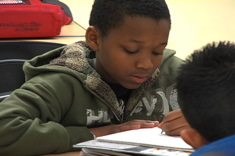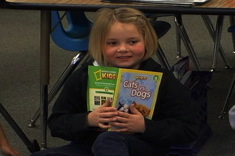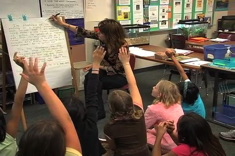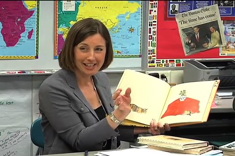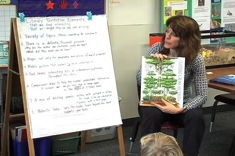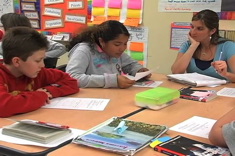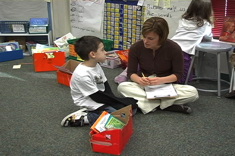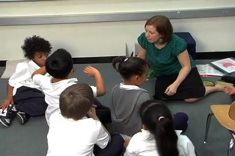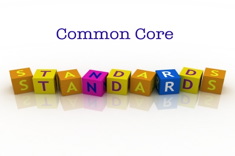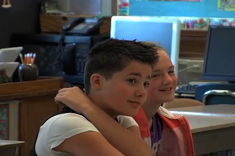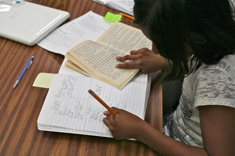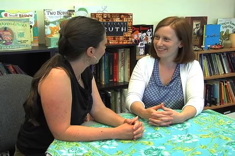Library
Choice Literacy Articles & Videos
The Choice Literacy library contains over 3,000 articles and 900 videos from 150+ contributors. Classic Classroom and Literacy Leadership subscribers have access to the entire library. Content is updated continuously, with five to six new features published each week.
Latest Content
Book Matchmaker: 5th Grade English Language Learners
Robin Heist is an elementary teacher looking for books for her older English language learners who are reading below grade-level expectations.
“School” Writing at the End of the Year
Writing about education is important in Erin Ocon's middle school classroom. Although Erin's students are in the eighth grade, this is a terrific project for readers of any age, and could even be used schoolwide for closure and celebration.
Previewing Nonfiction
Teachers are adding more nonfiction to their classroom libraries, and looking for ways to promote nonfiction with students in light of the emphasis on nonfiction in the Common Core. Franki Sibberson share tips for previewing nonfiction with students.
Planning for a Demonstration Lesson Part 1
In this first installment of a video series, Clare Landrigan takes a team of grades 3-5 teachers through the steps of planning for a demonstration lesson.
Common Core Conversations: Vocabulary
Amanda Adrian and Heather Rader explore connections between the Common Core and vocabulary instruction.
Second-Grade Punctuation Conference
Beth Lawson confers with a second grader, assisting as she works on her punctuation skills.
Frogs as Learning Ambassadors Part 2: Literary Nonfiction in 4th Grade
Andrea Smith explains how the classroom environment influences instruction in the second installment of this video series.
Planning for a Demonstration Lesson Part 2
In this second installment of a two-part video series, Clare Landrigan takes a team of grades 3-5 teachers through the steps of selecting a book for a demonstration lesson.
Digging Into Literary Nonfiction
Andrea Smith and her 4th grade students use an article from National Geographic for Kids to chart literary nonfiction elements.
Guiding a Struggling Middle School Book Club
What do you do about those book clubs that just don’t jell in your middle school classroom? Katie Doherty demonstrates how she guides a struggling group of sixth graders, helping them reflect and converse together.
The Sponge Summary Lesson Part 1
In this sequence of videos, Heather teaches a fourth-grade class, using the analogy of a sponge to explain how summaries work. In this first video excerpt, Heather reviews the work the class has already done on understanding the attributes of good summaries.
Best Practices in Spelling Instruction
Heather Rader wades through the research to find the best practices in spelling instruction.
Synthesis in Reading and the Reading Notebook
Beth Lawson helps one of her 3rd grade students write in response to a complex text he is reading, talking through how the writing might help him synthesize the plot of the story.
Helping Young Readers Become Independent
Teachers speak often about the importance of helping students become independent, but what does that look like in practical terms? Katie DiCesare considers her interactions with Evan, an emergent reader, on the road to independence.
Preparing Students for Summer Reading (ROUND-UP)
This round-up includes suggestions from Choice Literacy contributors Julie Johnson, Beth Lawson, Cathy Mere, Donalyn Miller, Colby Sharp, and Karen Terlecky.
Status of the Class and Monitoring Behavior
In this early year video from Beth Lawson’s second-grade classroom, Beth uses a writing status-of-the-class time to help students monitor their behavior, using peers as role models.
The Sponge Summary Lesson Part 2
In this sequence of videos, Heather teaches a fourth-grade class, using the analogy of a sponge to explain how summaries work. In this second video, Heather presents the powerful analogy of a sponge for summarizing.
Teaching and Assessing Persuasive Writing Skills
Heather Rader explores different ways into persuasive writing with teachers and students, highlighting the importance of helping students learn to cite and quote expert resources
Perspective as a Component of Text Complexity: A Common Core Booklist
Franki Sibberson tackles the connections between text complexity and perspective in this Common Core booklist.
Conferring: Stretching Words
In this conference with a second grader, Beth Lawson uses a visual aid and a hand motion to help a young English language learner understand the concept of stretching words in writing.
The Sponge Summary Lesson Part 3
In this sequence of videos, Heather teaches a 4th grade class, using the analogy of a sponge to explain how summaries work. In this third video, Heather and students cull down a text into the important points needed for a summary.
Guided Reading in Perspective
Cathy Mere puts guided reading in perspective, explaining how it works as one piece of the puzzle when it comes to fostering a lifelong love of reading in students.
Common Core Standards: Spreading the Word
Literacy leaders working in large districts face special challenges when implementing new programs. Suki Jones-Mozenter writes about the strategies being developed in one of the largest districts in the country.
Scaring Up Better Narratives Part I
Just before Halloween, Aimee Buckner leads a lesson on brainstorming topics in writer's notebooks using the mentor text Some Things Are Scary. In this first installment of a three-part series, Aimee reads the book and models her own thinking process and use of a writer's notebook.
Book Matchmaker: Teaching Theme in the Intermediate Grades
Students need strong mentor texts for understanding the concept of theme. Franki Sibberson shares many of her favorites in this Book Matchmaker.
The Sponge Summary Lesson Part 4
In this sequence of videos, Heather Rader teaches a 4th grade class, using the analogy of a sponge to explain how summaries work. In this fourth video, Heather and students discuss their summaries in progress
Using Video to Build the Home-School Connection
Video is a terrific tool for building connections between home and school. Heather Rader explains how Kelli Demonte uses video to guide children and communicate with families.
Stopping and Jotting
How can we be sure the writing tasks we ask of students are meaningful? Jennifer Jones looks at the issues of authenticity and control when it comes to assigning writing connected to reading in workshops.
Mentor Texts for Nonfiction Writing
Beth Lawson and Heather Rader meet to plan and share mentor texts for nonfiction writing in Beth’s fourth-grade classroom.
Scaring Up Better Narratives Part 2
Just in time for Halloween, Aimee Buckner leads a lesson on brainstorming topics in writer's notebooks using the mentor text Some Things Are Scary. In this second installment of a three-part series, Aimee continues to confer with students and helps everyone refine potential writing topics in their notebooks.
Browse Content By
Type
Category
- Assessment Tools
- Big Fresh Archives
- Booklists
- Choice Numeracy
- Classroom Design
- Common Core
- Community Building
- Conferring
- Content Literacy
- Digital Literacy
- English Language Learners
- Equity
- Family Relations
- Free Samples
- Guiding Groups
- Leadership
- Literacy Coaches
- Mentor Texts
- Minilessons
- New Teacher Mentors
- Podcasts
- Poetry
- Quote Collections
- Reading Strategies
- Self Care
- Struggling and Striving Learners
- Talking and Listening
- Teacher Study Groups
- Teaching Reading
- Teaching Writing
- Word Study and Vocabulary
Author
- Melissa Quimby
- Nawal Qarooni
- Gwen Blumberg
- Julie Cox
- The Lead Learners
- Hannah Tills
- Josie Stewart
- Ruth Metcalfe
- Mallory Messenger
- Becca Burk
- Jodie Bailey
- Vivian Chen
- Mary Brower
- Tiffany Abbott Fuller
- Stephanie Affinito
- Ruth Ayres
- Leigh Anne Eck
- Heather Fisher
- Shari Frost
- Julie Johnson
- Suzy Kaback
- Gigi McAllister
- Shirl McPhillips
- Melanie Meehan
- Cathy Mere
- Debbie Miller
- Tara Barnett and Kate Mills
- Tammy Mulligan
- Dana Murphy
- Bitsy Parks
- David Pittman
- Brenda Power
- Heather Rader
- Matt Renwick
- Mandy Robek
- Christy Rush-Levine
- Gretchen Schroeder
- Jen Schwanke
- Brian Sepe
- Katherine Sokolowski
- Stella Villalba
- Jennifer Vincent
Grade Level
Choice Literacy Membership
Articles
Get full access to all Choice Literacy article content
Videos
Get full access to all Choice Literacy video content
Courses
Access Choice Literacy course curriculum and training


